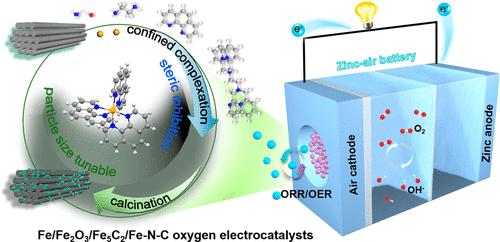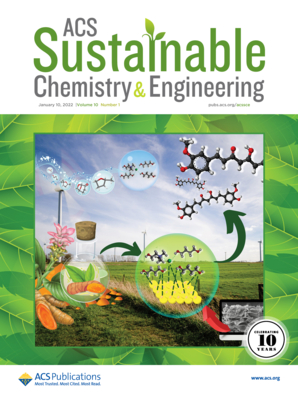Confined Complexation Induced Size Control of Fe/Fe2O3/Fe5C2 Multicomponent Nanoparticles Embedded in Fe, N-Doped Mesoporous Carbon toward Efficient Oxygen Electrocatalysis
IF 7.1
1区 化学
Q1 CHEMISTRY, MULTIDISCIPLINARY
引用次数: 0
Abstract
Controlling particle size and phase hybridization in metal-compound-based catalysts is crucial for optimizing oxygen catalytic activity in zinc-air batteries (ZABs), yet precise regulation remains a substantial challenge. In this work, a novel confined complexation-calcination method is explored to synthesize a series of size-controllable Fe/Fe2O3/Fe5C2 multicomponent nanoparticles embedded in Fe, N-doped mesoporous carbon (Fe–N–C). By modulation of the size of nitrogen-source ligands during confined complexation, the particle size and dispersion of Fe/Fe2O3/Fe5C2 are precisely regulated, resulting in varied oxygen electrocatalytic performances. Notably, the electrocatalyst synthesized using a medium-sized nitrogen-source ligand 1,10-phenanthroline (Fe/Fe2O3/Fe5C2/Fe–N–C (PEN)) demonstrates the smallest particle size (∼19 nm) and superior dispersion of Fe/Fe2O3/Fe5C2, which not only increases the exposure of active sites but also enhances charge/mass transfer efficiency. The optimized Fe/Fe2O3/Fe5C2/Fe–N–C (PEN) shows excellent catalytic activity for oxygen reduction reaction with a half-wave potential of 0.835 V vs RHE. In addition, high stability and good activity for oxygen evolution reaction are also demonstrated, establishing it as an ideal bifunctional catalyst for secondary ZABs. The assembled ZAB achieves a peak power density of 148.9 mW cm–2, surpassing that of its Pt/C-based counterpart. This work provides new insights into precise particle size control of advanced electrocatalysts for sustainable energy applications.

求助全文
约1分钟内获得全文
求助全文
来源期刊

ACS Sustainable Chemistry & Engineering
CHEMISTRY, MULTIDISCIPLINARY-ENGINEERING, CHEMICAL
CiteScore
13.80
自引率
4.80%
发文量
1470
审稿时长
1.7 months
期刊介绍:
ACS Sustainable Chemistry & Engineering is a prestigious weekly peer-reviewed scientific journal published by the American Chemical Society. Dedicated to advancing the principles of green chemistry and green engineering, it covers a wide array of research topics including green chemistry, green engineering, biomass, alternative energy, and life cycle assessment.
The journal welcomes submissions in various formats, including Letters, Articles, Features, and Perspectives (Reviews), that address the challenges of sustainability in the chemical enterprise and contribute to the advancement of sustainable practices. Join us in shaping the future of sustainable chemistry and engineering.
 求助内容:
求助内容: 应助结果提醒方式:
应助结果提醒方式:


